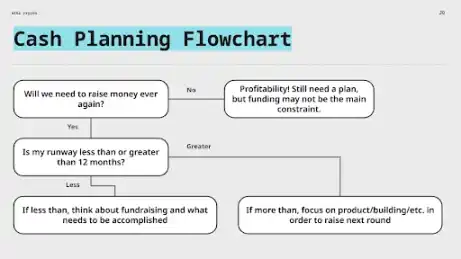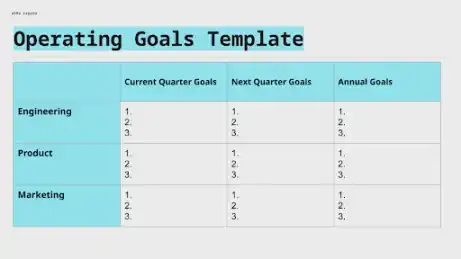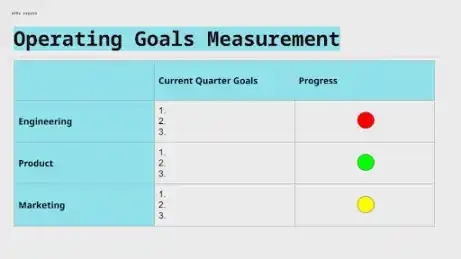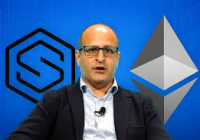a16z Partner: Don't Just Talk Vision, an Operating Plan Is the Amulet That Takes You Through the Cycle
For startups, especially those in the cryptocurrency field, an operational plan is a key tool to translate their vision into a concrete action plan. It helps to manage controllable affairs, avoid resource depletion, and prevent team breakdown.
Original Article Title: How to keep your business on track for success: Operating plans
Original Article Author: Emily Westerhold, a16z crypto Partner
Original Article Translation: Luffy, Foresight News
“If you fail to plan, you are planning to fail.” Benjamin Franklin may not have been speaking directly to startup founders when he said this, but it applies to them all the same. Founders, especially those in the cryptocurrency space, face numerous uncontrollable factors: volatile markets, constantly changing regulations, and high external expectations.
For this reason, focusing on what you can control becomes crucial, and that's where operating plans come into play. While operating plans may not sound glamorous, they are one of the most controllable and leveraged tools at your disposal, helping you translate vision into actionable progress without draining funds or demoralizing the team.
Conceptually, an operating plan is straightforward. It encompasses everything your business is doing: what tasks are being undertaken, who is responsible, what goals need to be achieved, total costs, and how outcomes are measured. However, the answers to these questions can be intricate, making it essential to have a plan to map them out.
Even if you've never created an operating plan for a business, you've likely done something similar in your personal life. For example, if you wanted to run a marathon, you would need a training plan to structure your preparation in the months leading up to the race. How far to run each time, when to increase distance, by how much, route selection, recovery strategies, and contingency plans for injuries. In the business world, your “marathon race day” could be a product launch, an initial public offering (IPO), or another major milestone. The principles apply in both scenarios.
However, do not confuse an operating plan with a strategic plan. A strategic plan outlines the macro blueprint of the company, the vision you sell to investors. On the other hand, an operating plan is the specific action plan that operationalizes the vision, transforming the strategic plan into actionable details involving personnel, costs, and timelines. To build a healthy and vibrant enterprise, both plans are indispensable.
Next, let's delve into what the operating plan should include.
Developing an Operating Plan
Start by focusing on four core elements of operations: People (who is responsible?), Timing (when is each task due?), Costs (what is the budget?), and Metrics (how is progress evaluated?).
An operating plan is an iterative process, so there is no need to obsess over the initial draft. There are plenty of best practices to reference, various frameworks to follow, and expensive consultants to hire. But the core work is to clearly articulate who is doing what in the company, and you can start by writing these down yourself, refining it later. For now, just ensure that the operational goals for a certain period are clear and organized.
Importantly, your plan must involve trade-offs. A company cannot do everything, so trade-offs are necessary. And these trade-offs should be difficult, prompting the leadership team to have thorough discussions about key priorities and non-priorities. No matter how successful a company is, trade-offs will always be an eternal topic, as constraints can actually drive wiser decisions.
Three Common Mistakes
When creating an operating plan, there are three common mistakes to be aware of.
1. Do not be overly optimistic about timing and expected outcomes. Information is constantly changing, so your plan needs to be flexible and adaptable. Be wary of various dependencies: such as "We need to launch product A before we can launch product B," "We must hire two engineers to develop that new feature," "Just by hiring one marketing person, revenue will increase by this much."
It may be attractive to include these factors in the operating plan, but if milestones are not met, dependencies can cause issues. If hiring those two engineers takes a long time, there may be a risk to the new feature development deadline. Therefore, while the operating plan can be optimistic, it must also be pragmatic. Allow yourself room to adjust course when circumstances change, and remember to adjust the subsequent timeline accordingly.
2. Do not try to do too much at once. Founders often have many ideas about the business, but time and resources are limited, and pursuing all ideas can escalate costs and dilute team focus.
Instead, strategically sequence the order of various activities. In other words, consider how different opportunities and capabilities can create conditions for other opportunities and capabilities. Perhaps launching a product can bring in new users, giving you the opportunity to leverage these users; perhaps investing in certain technology can open up new revenue streams. Consider how to prioritize business activities sensibly and allocate time and resources accordingly.
Of course, reality is often more complex than the plan. As a founder, you understand a range of opportunities related to the product. You may easily want to seize multiple opportunities, partly because you see a huge market behind each opportunity and partly because the performance of the core product may not have met expectations or progressed slowly, so you want to carve out multiple paths to success for yourself. However, the harsh reality is that a small team usually can only do one thing extremely well. While spreading attention may seem tempting, it often results in the most important things not being executed effectively.
To assess a company's focus, you can ask yourself two questions: What is the company's current top priority? Where do employees spend most of their time? If the answers are not consistent, there may be an issue.
3. The company needs measurable key performance indicators (KPIs). Even if your operational plan is outstanding, unless you can monitor the company's operational status, the entire plan may be in vain. Why? Because if you don't know how to measure success, you also cannot measure (or even be aware of) failure, which means you will struggle to deal with challenges and setbacks. KPIs don't have to be complex; even using red/yellow/green status indicators can be effective, but you must have KPIs.
Remember: What you incentivize will drive people's behavior. Consider carefully whether your KPIs can bring the best results for the company. For a simple example, you may want to link people's incentives to the results they achieve, rather than just looking at how many hours they have worked.
Budgeting Key Points
Budgeting is a critical component of any operational plan, as the operational plan must answer "How much will all of this cost?" Therefore, founders should understand some budgeting techniques.
Most of a company's major expenses are spent on employees. This is not always the case, but it is a useful rule of thumb, especially because founders sometimes underestimate the overall cost of hiring new employees. You must consider not only wages, benefits, and payroll taxes, but also hardware, software, licenses, travel expenses, and all other costs associated with employees. Many expenses are directly related to the number of employees, so modeling should be based on this when creating a budget.
Related to this is not forgetting to budget equity as you would cash. Equity management itself could be the subject of a separate article, but when creating a hiring plan, you should also budget for the relevant equity you intend to grant. The same principle applies if your project is distributing tokens to employees. In any case, having a comprehensive and clear compensation philosophy is crucial. Mistakes made early on often have a snowball effect.
Differentiate between fixed costs and variable costs to understand the flexibility of the budget. You need to know which parts of the budget can be adjusted and which cannot. Suppose you have to cut costs by 30% next week; do you know where to start? Or suppose the company is growing, and you want to increase investment; do you know where it is reasonable to increase investment? Achieving this may be more challenging for startups because of fewer variables. However, the better you understand these budget adjustment factors, the more adept you will be at making decisions.
Additional Tip: Whenever possible, negotiate with vendors and service providers to avoid signing multi-year contracts in order to maintain flexibility.
Scenario Planning is Your Friend. Any budget you create may have deviations; it's just a matter of the degree of deviation. This is true even for mature businesses as there are always factors that the budget cannot cover. Therefore, rather than fixating on one ideal future for the business, embrace scenario planning. Be ready to face various possible futures and assign a probability and confidence interval to each scenario. What factors might catch you off guard? What changes could disrupt the current state of the company? For example, when facing regulatory uncertainty, how would different regulatory outcomes shape the business? Treat the budget as a tool for learning and planning, a means to discuss and address various opportunities and uncertainties.
Have Sufficient Cash Reserves to Sustain 6 Months of Operations. Founders often find themselves caught off guard by cash burn issues. You might have a two-year cash runway at your company, but lack an operational plan to guide you. Perhaps by the end of the year, you realize you've hired an additional 5 people and the product development is delayed by 6 months. Suddenly, your funds are only enough to sustain 6 months of operations. Unless you can closely monitor cash burn, all your energy will be spent on fundraising or cost-cutting. Even if you successfully secure new funds, the fundraising process may take longer than anticipated, not to mention the legal expenses incurred. Moreover, the closer you are to running out of funds, the weaker your negotiating position becomes.
The key to avoiding cash flow problems lies in budget control. As a founder, do not overlook this responsibility. While you may outsource actual work to other team members, you should still conduct a monthly review, comparing the expected cash expenditure for the month with the actual cash expenditure. Are there significant differences between actual and expected spending? If so, what needs to be improved or adjusted? Are your cost estimates inaccurate, or was this just a one-time issue?
For founders, a useful tool is the Zero-Based Budgeting method. Currently, many companies base their next year's budget on the current budget, with a 10% increase or decrease. While this method is simpler than some, it does not encourage a deep understanding of the company's current needs. Zero-Based Budgeting requires you to start from scratch, carefully considering the actual expenses for your company in the upcoming year. The benefit is that you must find a valid reason for every expense, rather than just carrying over last year's budget. This helps you allocate the budget precisely where the business truly needs it.
Regarding financial management, especially for founders in the cryptocurrency field: Establishing an investment policy to provide guiding principles for fund management is crucial. While your risk tolerance usually depends on the state of your reserves, always remember that the primary goal is to preserve capital.
What Operating Model Is Your Business In?
There is no absolute correct or best framework for developing an operating plan. Whichever you choose, as long as it helps you address the core questions of the plan: who is doing what, when it will be done, how much it will cost, and how success will be measured.
However, before choosing a framework, you should first determine what operating model your business is in, as the operating model determines your priorities. This can be determined through a series of questions:

1. Does Your Business Still Need Funding?
The answer is likely "yes" because most early-stage venture-backed companies will seek further funding, but there are exceptions. If your business is already profitable, that's great. You still need an operating plan, but funding may not be its primary constraint. If you are not yet profitable, continue with the following questions.
2. Can Your Cash Reserves Sustain for Over 12 Months?
The key idea is that if your cash reserves can sustain for over 12 months, then funding may not be included in this year's plan. Perhaps your priorities are developing the product or building the team. But if your cash reserves cannot last for 12 months, the operating plan should include fundraising, cost reduction, seeking strategic partnerships and investment opportunities, or all of the above. You may also need to carefully examine expenses and look for ways to improve.
3. If Funding Is Needed, What Goals Do You Need to Achieve?
You must clearly define which milestones need to be achieved to convince investors to participate in the next round of funding. The right milestones depend on the company's situation and the funding round you are aiming for, so it's best to discuss this with your investors. For example, you may think launching a product will attract more funds, but investors may want to see product-market fit first.
Next, consider what resources are needed to achieve these milestones. Look at who needs to be hired, what other steps need to be taken, and how long you think it will take. List these costs in a spreadsheet. Is there enough cash in your bank account to cover these needs? If not, consider which variables can be adjusted to achieve cash flow balance. Will changing the order of activities help? How about changing the current priorities of the business?
Once you have identified the resources, consider how long your cash reserves can sustain by hiring or investing in these resources. Then ask yourself: with the current cash position of the company, are these cash reserves sufficient? If they are, then the foundation for developing the operating plan is solid. If they are not sufficient, you will need to reevaluate hiring, investments, or focus areas and iteratively adjust the plan.
Finally, establish some metrics to monitor the operational plan to understand its effectiveness. It is important to have regular monitoring at fixed intervals.
Operating Goals Template
The following worksheet can help you outline operational goals. One approach is to first define annual goals, then work back to the tasks that need to be accomplished each quarter, by each department, or even by each individual. The key is to write down your ideas because if you try to keep the entire operating plan in your head, you will likely overlook some things.

Below is a simple example of a measurement system used to track goal progress. With red/yellow/green indicators, you can easily report on goals progressing well and those causing concern at the weekly leadership team meetings. In this example, you might say there are no issues with the product, a slight hiccup with marketing but nothing to worry about, and a major problem in engineering that requires team discussion for resolution. Clearly, this system is not complex, and that's the point: find a way to monitor the operational plan that also holds people accountable.

Developing a business operating plan is crucial, but it should not be overcomplicated. Focus on substance over form, ensuring you can answer some simple questions such as who is doing what, when it will be completed, how much it will cost, and how it will be measured. Once you accomplish this, you have a basis to measure your performance and stay informed on whether the company's progress aligns with the plan.
Disclaimer: The content of this article solely reflects the author's opinion and does not represent the platform in any capacity. This article is not intended to serve as a reference for making investment decisions.
You may also like
Former BlackRock Executive Joseph Chalom: Ethereum is Redrawing the Global Financial Landscape

Ethereum OBV, Bullish Cross Indicate Possible Test Above $5,000 This Month

Bitcoin Price Faces Big Test – Resistance Could Decide Next Move

New York regulators urge banks to leverage blockchain to address crypto risks
Emerging technologies bring new and constantly evolving threats, which require new tools to address them.

